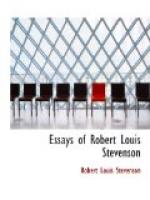[Note 3: “Trailing clouds of glory.” Trailing with him clouds of glory. This passage, from Wordsworth’s Ode on the Intimations of Immortality (1807), was a favorite one with Stevenson, and he quotes it several times in various essays.]
[Note 4: The leading distinction. Those who know dogs will fully agree with Stevenson here.]
[Note 5: The faults of the dog. All lovers of dogs will by no means agree with Stevenson in his enumeration of canine sins.]
[Note 6: Montaigne’s “je ne sais quoi de genereux.” A bit of generosity. Montaigne’s Essays (1580) had an enormous influence on Stevenson, as they have had on nearly all literary men for three hundred years. See his article in this volume, Books Which Save Influenced Me, and the discussion of the “personal essay” in our general Introduction.]
[Note 7: Sir Willoughby Patterne. Again a character in Meredith’s Egoist. See our Note 47 of Chapter IV above.]
[Note 8: Hans Christian Andersen. A Danish writer of prodigious popularity: born 1805, died 1875. His books were translated into many languages. The “memoirs” Stevenson refers to, were called The Story of My Life, in which the author brought the narrative only so far as 1847: it was, however, finished by another hand. He is well known to juvenile readers by his Stories for Children.]
[Note 9: Once he ceased hunting and became man’s plate-licker, the Rubicon was crossed. For a reversion to type, where the plate-licker goes back to hunting, see Mr. London’s powerful story, The Call of the Wild. ... The “Rubicon” was a small stream separating Cisalpine Gaul from Italy. Caesar crossed it in 49 B. C, thus taking a decisive step in deliberately advancing into Italy. “Plutarch, in his life of Caesar, makes quite a dramatic scene out of the crossing of the Rubicon. Caesar does not even mention it.”—B. Perrin’s ed. of Caesar’s Civil War, p. 142.]
[Note 10: The law in their members. Romans, VII, 23. “But I see another law in my members.”]
[Note 11: Sir Philip Sidney. The stainless Knight of Elizabeth’s Court, born 1554, died 1586. The pages of history afford no better illustration of the “gentleman and the scholar.” Poet, romancer, critic, courtier, soldier, his beautiful life was crowned by a noble death.]
[Note 12: The ideal of the dog is feudal and religious. Maeterlinck says the dog is the only being who has found and is absolutely sure of his God.]
[Note 13: Damnable and parlous than Corin’s in the eyes of Touchstone. See As You Like It, Act III, Sc. 2. “Sin is damnation: Thou art in a parlous state, shepherd.”]
[Note 14: Cairn-gorms. Brown or yellow quartz, found in the mountain of Cairngorm, Scotland, over 4000 feet high. Stevenson’s own dog, “Woggs” or “Bogue,” was a black Skye terrier, whom the author seems here to have in mind. See Note 20 of this Chapter, below, “Woggs.”]




